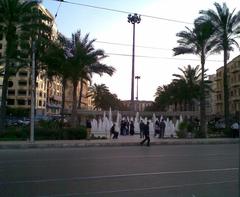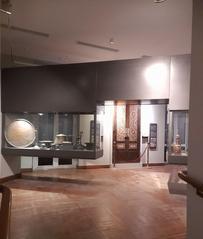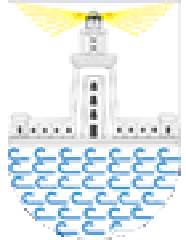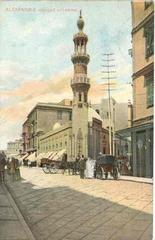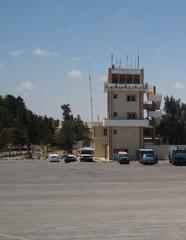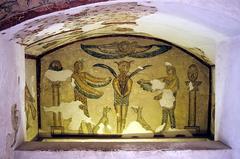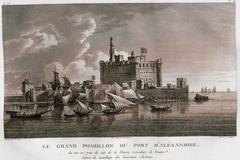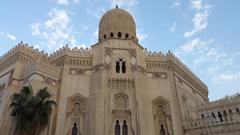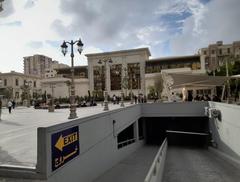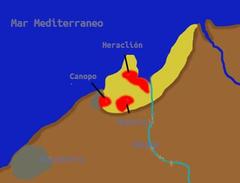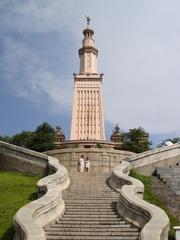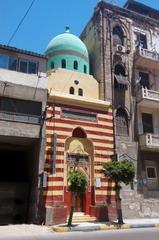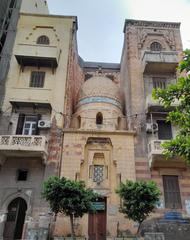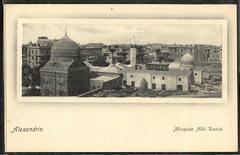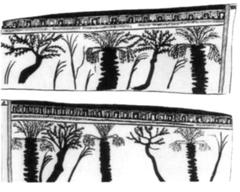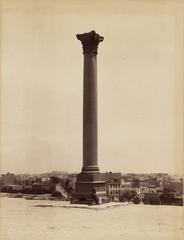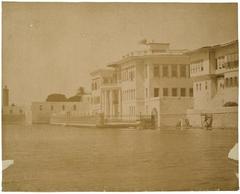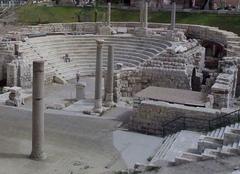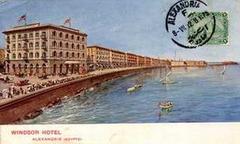
Alexandria Naval Unknown Soldier Memorial Visiting Guide
Date: 17/07/2024
Introduction
The Alexandria Naval Unknown Soldier Memorial, situated on the picturesque Corniche of Alexandria, Egypt, stands as a profound tribute to the valor and sacrifices of Egypt’s naval forces. Inaugurated in 1949, this monument symbolizes national pride and the collective memory of those who perished in service to their country, particularly those whose remains were never recovered or identified (source). The early 20th century saw a surge in Egyptian nationalism and a renewed focus on maritime legacy, culminating in the construction of this poignant memorial. Its strategic location on Alexandria’s waterfront promenade offers breathtaking views of the Mediterranean Sea and serves as a constant reminder of Egypt’s enduring naval heritage. Designed with a blend of modern and traditional elements, the memorial features a sail-shaped structure of Aswan granite, symbolizing strength and resilience. An eternal flame at the base serves as a universal symbol of remembrance, while intricate bas-reliefs depict significant naval battles, highlighting the bravery of Egyptian sailors (source).
Table of Contents
- Introduction
- Historical Context and Significance
- Architectural Design and Symbolism
- Cultural Impact and Legacy
- Visitor Information
- FAQ
- Conclusion
Historical Context and Significance
Early 20th Century: A Period of Growing Nationalism and Naval Aspirations
The early 20th century witnessed a surge in Egyptian nationalism, fueled by a desire for independence from British rule. This period also saw a renewed interest in Egypt’s maritime legacy, with calls for a strong navy to protect its extensive coastline and project its influence in the region.
The Impact of World War II
World War II had a profound impact on Egypt, drawing the country into the global conflict. Although Egypt remained officially neutral for much of the war, its strategic location in North Africa made it a key battleground between the Allied and Axis powers. The Egyptian navy, though modest in size, played a vital role in safeguarding the Suez Canal, a crucial waterway for Allied shipping.
The Decision to Honor the Unknown Soldier
In the aftermath of World War II, many nations sought to commemorate the sacrifices of their soldiers and sailors who perished in the conflict. Egypt, too, felt the need to honor its fallen heroes, particularly those whose remains were never recovered or identified. The concept of the “Unknown Soldier” emerged as a poignant symbol of this collective sacrifice, representing all those who gave their lives in service to their country.
1949: Unveiling of the Memorial
The Alexandria Naval Unknown Soldier Memorial was inaugurated in 1949, a period marked by both national pride and the lingering wounds of war. The memorial’s location on the Corniche, Alexandria’s famed waterfront promenade, was carefully chosen for its symbolic significance. The Corniche, with its panoramic views of the Mediterranean Sea, serves as a constant reminder of Egypt’s enduring connection to the sea and its naval heritage.
Architectural Design and Symbolism
The Main Structure: A Sail of Granite
The memorial’s design, a collaborative effort by Egyptian architects and sculptors, reflects a blend of modern and traditional elements. The central cenotaph, a raised tomb-like structure, is crafted from Aswan granite, a material deeply ingrained in Egyptian architectural history. The cenotaph is adorned with intricate carvings and inscriptions, including verses from the Quran and patriotic poems, further emphasizing the memorial’s solemnity and national significance.
The Eternal Flame: A Beacon of Remembrance
At the base of the sail-shaped structure burns an eternal flame, a universal symbol of remembrance and respect for fallen soldiers. The flame, fueled by a continuous gas supply, serves as a constant reminder of the sacrifices made by the unknown soldiers and the enduring gratitude of the nation.
Bas-Reliefs: Depicting Naval Battles and Heroism
The base of the memorial features intricate bas-reliefs carved into the granite. These carvings depict scenes from significant naval battles in Egyptian history, showcasing the bravery and skill of Egyptian sailors throughout the ages. The bas-reliefs serve as a visual chronicle of Egypt’s maritime heritage, highlighting the pivotal role of the navy in shaping the nation’s history.
Surrounding Plaza: A Space for Reflection
The memorial is set within a spacious plaza paved with polished granite slabs. This open space provides ample room for visitors to move around and appreciate the memorial from different angles. The plaza’s design encourages contemplation and reflection, offering a serene environment to honor the memory of the fallen.
Cultural Impact and Legacy
Navy Day Commemorations
The Egyptian Navy celebrates its annual Navy Day on October 21st, marking the anniversary of the destruction of the Israeli destroyer Eilat in 1967. Although the main celebrations are typically held elsewhere, the Alexandria Naval Unknown Soldier Memorial often hosts wreath-laying ceremonies and tributes to fallen sailors.
Military Anniversaries
The memorial is also utilized for commemorative events on other significant military anniversaries, such as the anniversary of the October War (Yom Kippur War). These events may involve military parades, speeches by dignitaries, and moments of silence to honor the sacrifices of Egyptian soldiers.
Visits by Foreign Dignitaries
When visiting dignitaries, especially those with naval or military ties, visit Alexandria, paying respects at the Alexandria Naval Unknown Soldier Memorial is often included in their itinerary. This practice signifies respect for Egypt’s military history and sacrifices.
Visitor Information
Visiting Hours and Ticket Information
The Alexandria Naval Unknown Soldier Memorial is open to the public daily. The visiting hours are from 9:00 AM to 5:00 PM. Admission is free, making it an accessible landmark for all visitors.
Accessibility
The memorial is accessible to visitors with disabilities, offering ramps and pathways that accommodate wheelchairs and strollers. There are also benches and shaded areas for rest and reflection.
Travel Tips
- Best Time to Visit: Early mornings or late afternoons are ideal for visiting to avoid the midday heat and enjoy a more peaceful experience.
- Photography: The memorial and its surroundings offer excellent photographic opportunities, especially during sunrise and sunset when the light is most dramatic.
- Guided Tours: Consider joining a guided tour to gain a more comprehensive understanding of the memorial’s history and significance.
Nearby Attractions
While visiting the Alexandria Naval Unknown Soldier Memorial, consider exploring other nearby historical sites such as the Alexandria National Museum, the Citadel of Qaitbay, and the Bibliotheca Alexandrina. Each of these landmarks provides a deeper insight into Alexandria’s rich history and cultural heritage.
Special Events and Guided Tours
While the memorial does not frequently host large-scale events, it is worth inquiring about any special events or guided tours that might coincide with your visit. These can provide deeper insights into the memorial’s significance and history.
Good Spots for Photography
The Alexandria Naval Unknown Soldier Memorial offers several picturesque spots for photography. The best views are during the golden hour, either shortly after sunrise or before sunset, when the lighting enhances the memorial’s solemn beauty.
FAQ
What are the visiting hours of the Alexandria Naval Unknown Soldier Memorial? The memorial is open daily from 9:00 AM to 5:00 PM.
How much are the tickets for the Alexandria Naval Unknown Soldier Memorial? Admission to the memorial is free.
Is the memorial accessible for visitors with disabilities? Yes, the memorial is accessible, offering ramps and pathways for wheelchairs and strollers.
What are some nearby attractions to visit? Nearby attractions include the Alexandria National Museum, the Citadel of Qaitbay, and the Bibliotheca Alexandrina.
Are there guided tours available? Yes, guided tours are available and recommended for a more comprehensive understanding of the memorial.
Conclusion
The Alexandria Naval Unknown Soldier Memorial stands as a significant testament to Egypt’s rich naval history and the sacrifices made by its sailors. Over the decades, it has evolved into a revered landmark, attracting visitors from all walks of life who come to pay their respects and reflect on the sacrifices of past generations (source). The memorial’s architectural design, featuring a sail-shaped granite structure and an eternal flame, embodies strength, resilience, and the enduring memory of the fallen. Its location on Alexandria’s Corniche not only offers stunning views but also serves as a constant reminder of the city’s maritime heritage (source). By visiting this memorial, individuals engage in a collective act of remembrance, honoring the bravery and dedication of Egypt’s naval heroes. Whether you’re exploring the nearby historical sites or participating in guided tours, the Alexandria Naval Unknown Soldier Memorial provides a profound and moving experience that connects visitors to Egypt’s rich cultural and military heritage (source).
References
- Visiting the Alexandria Naval Unknown Soldier Memorial - History, Significance, and Visitor Information, 2024, Author source
- Exploring the Alexandria Naval Unknown Soldier Memorial - Design, History, and Visitor Tips, 2024, Author source
- Visiting the Alexandria Naval Unknown Soldier Memorial - History, Significance, and Visitor Information, 2024, Author source




